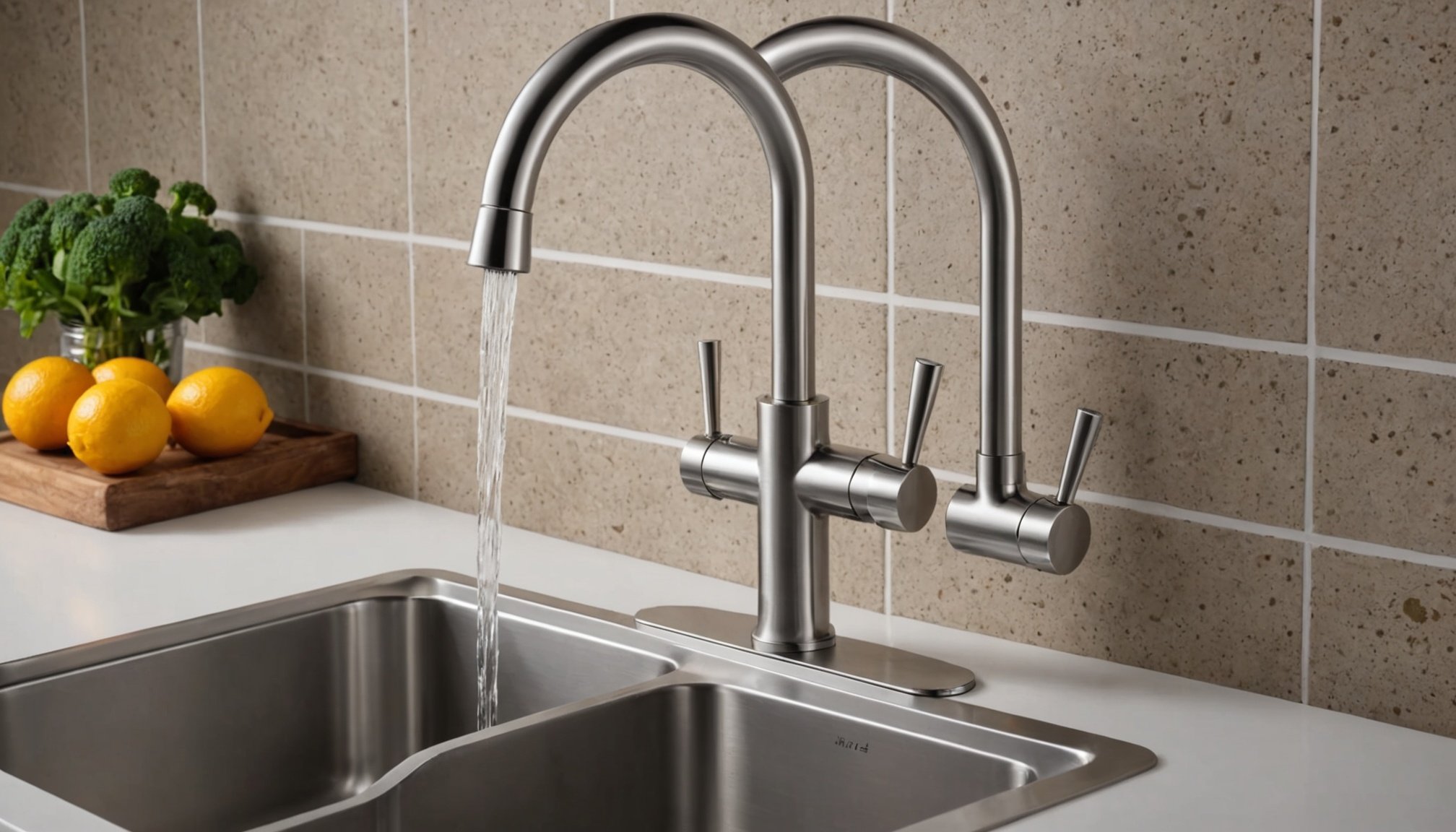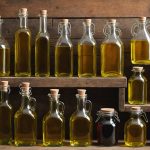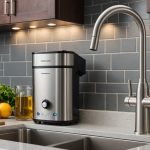Choosing the right water-saving kitchen faucet not only reduces your water bills but also contributes to a more sustainable home. With numerous options available in the UK, making an informed decision can feel overwhelming. This guide simplifies the process, offering insights into features, styles, and water efficiency ratings. Equip yourself with the knowledge to select a faucet that meets your needs and benefits the environment. Save water and enhance your kitchen simultaneously. Let’s explore the essential aspects of this important purchase.
Understanding Water-Saving Kitchen Faucets
Exploring the benefits and efficiency of modern kitchen solutions.
Also read : Top UK Kitchen Extractors for Eliminating Cooking Odors: Find the Best Choices
Importance of Water-Saving Kitchen Faucets
Water-saving kitchen faucets are designed to reduce water consumption without sacrificing performance. These faucets use advanced technologies, such as aerators and flow restrictors, to minimize water flow while maintaining strong pressure. This is crucial in promoting water efficiency and reducing household water bills.
Water Usage in Typical Kitchens
In a typical kitchen, activities such as cooking, cleaning, and dishwashing can lead to significant water usage. The Environmental Protection Agency estimates that a standard kitchen faucet can use 2.2 gallons per minute. By switching to a water-efficient model, households can achieve substantial savings and contribute to environmental sustainability.
Have you seen this : Top UK Online Retailers for Quality Kitchen Essentials: Your Ultimate Guide
Environmental Benefits
The adoption of water-saving kitchen faucets offers notable environmental advantages. By lowering water consumption, these faucets help conserve vital natural resources. This reduction in water usage also decreases the energy needed for water heating, further enhancing their environmental impact.
- Benefits of Water-Saving Faucets:
- Reduces water bills
- Conserves natural resources
- Lowers energy consumption
Embracing water efficiency in the kitchen is a practical step towards a more sustainable future, offering both economic and ecological benefits.
Key Criteria for Choosing a Water-Saving Faucet
Delving into essential factors for selecting the right kitchen solution.
Understanding Flow Rate
Flow rate is a crucial factor when selecting kitchen faucets. It determines how much water is used per minute. A lower flow rate means less water consumption, making it essential for water-saving features. Typical water-efficient models offer a flow rate of 1.5 gallons per minute or less. This reduction significantly impacts your water usage, promoting sustainability.
Key Features to Look For
When choosing a water-saving faucet, consider features like aerators and flow restrictors. These components are designed to maintain water pressure while reducing flow. Look for models with adjustable settings to customize your water usage according to your needs.
- Aerators: Mix air with water, reducing flow without losing pressure.
- Flow restrictors: Limit water flow to a set rate.
- Adjustable settings: Allow customization for varied tasks.
Importance of Certifications and Standards in the UK
Certifications ensure that a faucet meets specific efficiency standards. In the UK, look for the Water Efficiency Product Label (WEPL) or Water Regulations Advisory Scheme (WRAS) approval. These certifications guarantee that the faucet adheres to high water-saving standards, providing peace of mind and assurance in your purchase.
Popular Water-Saving Faucet Models in the UK
Exploring the best kitchen faucets UK has to offer.
Overview of Top Brands and Models
In the UK, several top brands offer best kitchen faucets with water-saving features. Brands like Grohe, Hansgrohe, and Bristan lead the market with innovative designs. These models integrate water-saving technologies to reduce consumption while maintaining performance.
Comparison of Features and Pricing
When comparing product features, consider aspects like flow rate, material quality, and ease of installation. Grohe's Essence model, for instance, boasts a 1.5 gallons per minute flow rate and a sleek design. Pricing varies, with models ranging from £50 to £200, depending on features and brand reputation.
| Brand | Model | Flow Rate | Price Range |
|---|---|---|---|
| Grohe | Essence | 1.5 GPM | £150-£200 |
| Hansgrohe | Focus | 1.2 GPM | £100-£150 |
| Bristan | Artisan Evo | 1.8 GPM | £50-£100 |
Summary of User Reviews and Satisfaction Ratings
User ratings highlight satisfaction with these water-saving faucets. Many appreciate the balance between aesthetics and functionality. Grohe models often receive high praise for durability and design, while Bristan is noted for affordability. Overall, these best kitchen faucets UK offer a blend of efficiency and style, meeting diverse consumer needs.
Installation Tips for Water-Saving Faucets
Tackling installation with ease for efficient water use.
Step-by-Step Guide to Installing a Water-Saving Faucet
Installing a water-saving faucet can be a straightforward DIY project with the right tools and guidance. Begin by shutting off the water supply to prevent leaks. Remove the existing faucet by loosening the nuts underneath the sink. Clean the area to ensure a proper seal for the new installation. Align the new faucet with the holes and secure it with mounting nuts. Reconnect the water supply lines, ensuring they are tightly fastened to prevent leaks. Finally, turn on the water supply and check for any leaks.
Common Installation Challenges and Solutions
Despite careful preparation, some challenges may arise during faucet installation. A common issue is dealing with old or corroded plumbing, which can complicate removal. In such cases, using penetrating oil can ease the process. Another challenge is ensuring a watertight seal; using plumber’s tape on threaded connections can help prevent leaks.
Importance of Professional Installation in Certain Situations
While many can handle a DIY approach, certain situations may require professional plumbing advice. Complex installations involving multiple water lines or outdated plumbing systems benefit from expert intervention. Professional installation ensures that the water-saving faucet is correctly fitted, providing peace of mind and optimal performance.
UK Regulations and Standards for Kitchen Faucets
Exploring the regulatory landscape for efficient kitchen solutions.
Overview of UK Plumbing Regulations
In the UK, plumbing regulations play a crucial role in ensuring that kitchen faucets meet safety and efficiency standards. These regulations are designed to uphold water-saving standards, promoting sustainable water use. Compliance with these regulations ensures that faucets are not only safe but also environmentally friendly.
Key Standards and Certifications to Consider
When selecting a faucet, it's vital to consider key certifications that indicate compliance with water-saving standards. The Water Efficiency Product Label (WEPL) and the Water Regulations Advisory Scheme (WRAS) are two important certifications. These labels assure consumers that the faucet meets stringent plumbing regulations UK mandates, ensuring high performance and efficiency.
- WEPL: Indicates high water efficiency
- WRAS: Ensures compliance with UK plumbing standards
- Compliance: Guarantees product safety and efficiency
Impact of Regulations on Consumer Choices
The impact of plumbing regulations UK on consumer choices is significant. These regulations guide consumers towards products that align with water-saving standards. By choosing certified faucets, consumers can be confident in their contribution to environmental sustainability. This compliance not only enhances performance but also supports informed decision-making in the marketplace.
Potential Savings from Water-Saving Faucets
Evaluating the financial impact of efficient kitchen solutions.
Estimating Savings on Water Bills
Investing in water-saving faucets can lead to significant cost savings on your water bills. These faucets reduce water flow, which directly impacts the amount of water used during daily kitchen activities. Households can see a reduction of up to 30% in water usage, translating into lower monthly expenses. For instance, a family of four could save approximately £100 annually by switching to efficient models.
Long-term Financial Benefits
The long-term financial benefits of investing in water-saving faucets extend beyond immediate savings. Over time, these savings accumulate, making the initial investment highly cost-effective. In addition to reduced water bills, the decreased energy required for heating less water further enhances energy efficiency, contributing to overall household savings.
Comparison with Traditional Faucets
When comparing water-saving faucets to traditional models, the cost-effectiveness becomes clear. While the upfront cost of efficient models might be higher, the long-term savings outweigh the initial expenditure. Traditional faucets may appear cheaper initially, but they lead to higher water and energy bills over time.
- Traditional Faucets: Higher water usage, lower initial cost
- Water-Saving Faucets: Lower water usage, higher initial cost, greater long-term savings
Sustainability and Environmental Benefits
Exploring the eco-friendly impact of water-saving faucets.
Role of Water-Saving Faucets in Promoting Sustainable Living
Water-saving faucets are pivotal in advancing sustainable living by significantly reducing water consumption. These eco-friendly products ensure that households align with broader environmental goals. By integrating these faucets, homes contribute to substantial water conservation efforts, supporting a more sustainable future.
Broader Impact on Water Conservation Efforts
The adoption of eco-friendly products like water-saving faucets extends beyond individual households. It plays a crucial role in global water conservation initiatives. By reducing water usage, these faucets help preserve vital natural resources. This aligns with conservation goals, enhancing the sustainability of entire communities.
- Eco-friendly products: Reduce water waste
- Sustainable living: Supports environmental goals
- Water conservation: Essential for future generations
Aligning Household Choices with Environmental Goals
Choosing water-saving faucets aligns household decisions with environmental objectives. These choices reflect a commitment to sustainable living and conservation. By opting for eco-friendly solutions, households can actively participate in preserving the environment. This not only benefits the planet but also promotes a responsible lifestyle.
| Benefit | Impact on Environment |
|---|---|
| Reduced Water Use | Preserves Resources |
| Lower Energy Use | Decreases Carbon Footprint |
| Eco-Friendly Design | Encourages Sustainable Choices |
Maintenance Tips for Water-Saving Faucets
Ensuring longevity and efficiency through proper care.
Best Practices for Maintaining Water-Saving Faucets
Regular faucet maintenance is essential to ensure the longevity and efficiency of your water-saving faucets. Begin by routinely cleaning the aerator to prevent mineral buildup, which can impede water flow. Use a soft brush and vinegar solution for effective cleaning. Periodically check for leaks around the base and handles, tightening connections as needed.
Common Issues and How to Address Them
Even with diligent care, common issues may arise. Low water pressure can often be traced back to a clogged aerator. In such cases, remove and clean the aerator to restore optimal flow. Leaks are another frequent problem; replacing worn-out washers or O-rings can often resolve these issues. If problems persist, consult a professional to avoid further damage.
Importance of Regular Maintenance for Efficiency
Regular faucet maintenance not only ensures smooth operation but also maintains the efficiency of your water-saving faucets. By addressing minor issues promptly, you prevent larger problems that could compromise water conservation efforts. Consistent care ensures that your faucets continue to deliver the water-saving benefits they were designed for, supporting both economic and environmental goals.
- Routine cleaning: Prevents mineral buildup
- Check for leaks: Ensures watertight connections
- Replace worn parts: Maintains performance and efficiency
User Reviews and Recommendations
Analyzing consumer feedback for informed decisions.
Summary of User Experiences
User experiences with water-saving kitchen faucets reveal varied insights. Many customers appreciate the efficiency and cost savings these models offer. A frequent highlight is the balance between water pressure and reduced consumption. However, some users report issues with installation and maintenance, emphasizing the need for professional assistance in complex setups.
Common Praises and Complaints
Customer testimonials often praise the durability and design of top models, such as those from Grohe and Hansgrohe. Users commend the sleek aesthetics and robust performance. On the downside, common complaints include difficulties with the initial setup and occasional leaks. These issues typically arise from improper installation or lack of maintenance.
Recommendations Based on Feedback
Based on user reviews and expert recommendations, choosing a model with strong customer support is advised. Opt for faucets with clear installation guides and accessible service options. Models that offer a warranty and have received positive product reviews for ease of use and reliability are highly recommended.
- Praises: Efficiency, design, durability
- Complaints: Installation challenges, maintenance issues
- Recommendations: Opt for models with strong support and warranties
These insights help consumers make informed decisions, ensuring satisfaction with their water-saving faucet choices.











